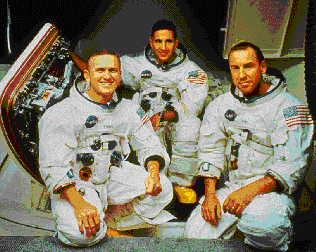
Apollo 8 (AS-503)
Man around the Moon
 Apollo 8 was launched from Cape Kennedy, Fla., at 7:50 a.m., EST, on December 21, 1968. Two hours 50 minutes later, translunar injection was performed; and astronauts Col. Frank Borman, the commander; Capt. James A. Lovell, Jr., the command module pilot; and Major William A. Anders, the lunar module pilot, were on their way to the Moon.
The Spacecraft was placed in an elliptical lunar orbit at 69 hours 8 minutes after liftoff. After flying two elliptical orbits of 168.5 by 60 nautical miles with an inclination of 12 degrees to the Equator, the spacecraft was placed in a nearly circular orbit of 59.7 by 60.7 nautical miles in which it remained for eight orbits.
At 89 hours 19 minutes, transearth injection was performed from behind the Moon. A nearly flawless mission was completed on the morning of December 27 when splashdown occurred in the Pacific Ocean after a total elapsed time of 147 hours.
Apollo 8 was launched from Cape Kennedy, Fla., at 7:50 a.m., EST, on December 21, 1968. Two hours 50 minutes later, translunar injection was performed; and astronauts Col. Frank Borman, the commander; Capt. James A. Lovell, Jr., the command module pilot; and Major William A. Anders, the lunar module pilot, were on their way to the Moon.
The Spacecraft was placed in an elliptical lunar orbit at 69 hours 8 minutes after liftoff. After flying two elliptical orbits of 168.5 by 60 nautical miles with an inclination of 12 degrees to the Equator, the spacecraft was placed in a nearly circular orbit of 59.7 by 60.7 nautical miles in which it remained for eight orbits.
At 89 hours 19 minutes, transearth injection was performed from behind the Moon. A nearly flawless mission was completed on the morning of December 27 when splashdown occurred in the Pacific Ocean after a total elapsed time of 147 hours.
The primary purpose of this mission was to further progress toward the goal of landing men on the Moon by gaining operational experience and testing the Apollo system. However, a great effort was also made to accomplish worthwhile scientific tasks with photography and visual information by the astronauts.
From NASA SP-201, Analysis of Apollo 8 photography and visual observations.
 Factoids
Factoids
-
- Spacecraft name: Apollo Eight.
- The mission was the second flight in the Apollo program and the first manned flight on the Saturn V rocket.
- Third mission for Lovell (Gemini VII, Gemini XII),second for Borman (Gemini VII) and first for Anders.
- Backup crew was Commander Neil A. Armstrong, Command Module Pilot Edwin E. Aldrin, Jr. and Lunar Module Pilot Fred W. Haise, Jr.
- A lunar module was not carried but a Lunar Test Article which is equivalent in weight to a lunar module was carried as ballast.
- Launched from Complex 39A at Kennedy Space Center and marked the first manned use of the Moonport.
- Saturn V launch vehicle with the Apollo spacecraft on top stood 363 feet (110 meters) tall.
- The five first-stage engines developed combined thrust of 7.5 million pounds at liftoff.
- First humans to journey to the Earth's Moon.
- First pictures of Earth from deep space.
- New world speed record: 24,200 mph (38,938 km/hr).
- First live TV coverage of the lunar surface.
- Mission duration: 146 hours 59 minutes 49 seconds.
Images from mission
Standard figures from Press Release package.
Michael J. Tuttle, June 19, 1995




 Main Apollo page
Main Apollo page